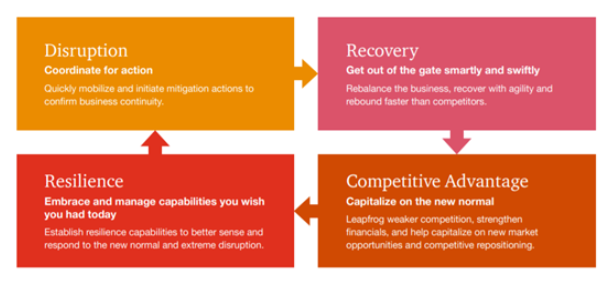How to Stay Competitive for the Manufacturing Industry

The COVID-19 pandemic greatly disrupted the global economy. Manufacturers faced a variety of challenges such as labor shortage, supply chain instability, inventory shortage under a JIT (Just-In-Time) system. Production often halted. More than one year into the pandemic, companies need to reshape their operations to get ahead, stay competitive, and respond quickly to crises in the future.
Agile Operations
When crises occur, companies can reduce the negative impacts if decisions are made quickly. Thanks to 4IR technology, many companies can accelerate decision-making and rely on the digital form to maintain operations in the pandemic. For example, cloud data allows employees to work from home, and allow factories to operate remotely. AI and other digital technologies calculate for demand changes to adjust production plans. Digital Twin combines a large amount of data to mimic physical production digitally. Another use of digital twin under covid is to predict the spread of the virus, and patients’ disease progressions to help with decision-making such as the assignment of respirators.
Supply Chain Resilience
The manufacturing industry has been relying on JIT (Just-In-Time) inventory management system to reduce inventory costs and risks. However, demand volatiles drastically in the pandemic, which makes low inventory extremely risky. When demand prediction is not accurate or upstream supply is insufficient, the production may be forced to come to a halt.
During the recovery from the pandemic, companies have to rethink supply chain planning and management. For example, cooperate with local suppliers to ensure convenience. Diversify material sources to spread risk. Additionally, manufacturers can build near-real-time tracking systems with RFID, AI, or other digital solutions to achieve production and inventory transparency.
Workforce Management
This global crisis makes the already tight labor market in the manufacturing industry even tighter, and manufacturers encounter labor shortages. While the economy is recovering, entry-level and middle-skill positions are still unfilled. According to a survey by Deloitte, 77% of the manufacturers anticipate continuing understaffed issues even after 2021. Therefore, managing the workforce effectively is crucial to secure productivity during demand recovery. On the other hand, the required skills by the technical personnel in the future are no longer the same as in the past. When adopting innovative technologies, manufacturers need to upskill the employees, reskilling them with digital skills to avoid losing potential benefits from innovation due to skill gaps. Also, cultivating adaptivity and agility to technology will help the organization respond quickly to disruptions.
In the recently published supply chain review report by the White House, the US examines the lack of competitiveness in the domestic industries of semiconductor and advanced packaging, large capacity batteries, critical minerals and materials, and pharmaceuticals and active pharmaceutical ingredients. They hope to eliminate the weakness results from the long-term emphasis on cost and efficiency and not strongly developing the manufacturing industry. The pandemic shows the industry that cost is not the core competitiveness anymore. Amid a crisis with great uncertainty and instability, resilience and agility are the core strengths. Manufacturers used to consider digital transformation technology as a tool to reduce cost. However, companies now are considering 4IR technology as a competitive advantage to stay agile and innovative.
Source:
PwC: how manufacturers can stay competitive amidst COVID-19, PwC
Creating pathways for tomorrow’s workforce today, Beyond reskilling in manufacturing, Deloitte
BUILDING RESILIENT SUPPLY CHAINS, REVITALIZING AMERICAN MANUFACTURING, AND FOSTERING BROAD-BASED GROWTH, The White House
https://www.whitehouse.gov/wp-content/uploads/2021/06/100-day-supply-chain-review-report.pdf
